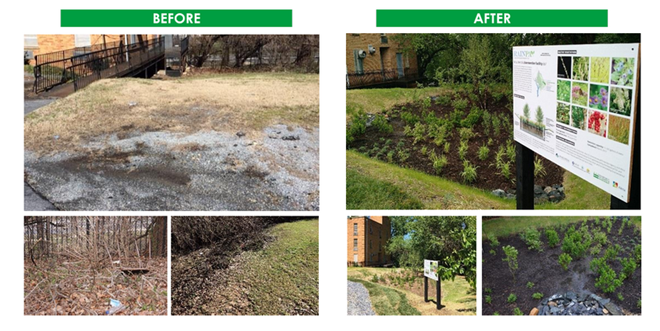![[Caption: This rain garden in DC’s Ward 7 captures and cleans rain where it falls, combating pollution from run-off.]](/sites/default/files/2023-08/Green%20Infrastructure.png)
When we hear the word “infrastructure”, pipes and concrete often come to mind. But what if infrastructure looked like green gardens and lush trees, collecting stormwater when it rains and providing shade on sizzling summer days?
This rain garden in DC’s Ward 7 captures and cleans rain where it falls, combating pollution from run-off.
What is Green Infrastructure?
Green infrastructure (GI) manages stormwater by using natural systems to collect and clean rain where it falls. Beyond this important function, green infrastructure installations can also serve as neighborhood amenities, beautifying outdoor spaces in our communities with greenery and providing homes for local wildlife.
What does Green Infrastructure look like?
You may have seen green infrastructure projects like these throughout the District of Columbia. GI can come in many shapes and sizes, including rain gardens, green roofs, permeable pavement, and rain barrels. When incorporated with other features such as park benches, artistic murals, and educational signage these installations can offer practical and aesthetic benefits to residents.
This example of green infrastructure in a DC schoolyard not only helps mitigate runoff pollution but provides a beautiful environment for education and enjoyment.
What are the benefits of Green Infrastructure?
Green infrastructure provides numerous environmental, social, and economic benefits.
Environmental: As climate change continues to disproportionately affect vulnerable populations, GI plays a crucial role in reducing some flood risks, mitigating urban heat, and combating polluted runoff from entering our rivers (like the Anacostia!).
Social: GI has the potential to transform urban streets into attractive green spaces, offering community members accessible ways to spend time outside. Increased access to green space can lead to improved mental health, reducing rates of anxiety, depression, and stress.
Economic: Green infrastructure can also lead to increased property values, reduced property management costs, and green job creation.
This example of green infrastructure in a DC schoolyard not only helps mitigate runoff pollution but provides a beautiful environment for education and enjoyment.
How can I take advantage of Green Infrastructure initiatives in my neighborhood?
The District’s green infrastructure programs offer a range of opportunities and incentives for residents, property owners, and businesses to embrace GI projects. For example, the innovative Stormwater Retention Credit (SRC) Trading Program fosters relationships between property owners and businesses that can install and maintain green infrastructure at no cost to the property owners. The SRC Trading Program even allows for revenue generation through the construction of voluntary GI projects.
For a local example of SRC program in action, check out the rain garden that was installed at the Progressive National Baptist Convention (PNBC) Headquarters in Ward 7.

Before and after photos of the rain garden installed at the PNBC Headquarters in Ward 7
Are you interested in green infrastructure projects in your neighborhood?
Whether you are a proud DC property owner, engaged resident, or passionate supporter of green initiatives, we want to hear from you. By participating in this brief survey, you can help us gather valuable feedback and insights so we can all enjoy the benefits of green infrastructure.
Nathan Peebles, DC Program Coordinator
npeebles@cleanwater.org
